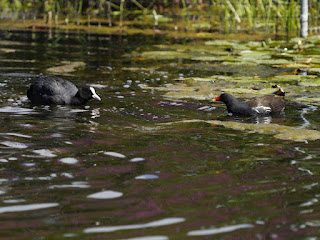... but its mother has seen hotter days and was looking quite comfortable in a nearby tree.
A young Egyptian Goose sprawled on the sun-heated stone edge of the Serpentine.
The dominant female Mute Swan on the Long Water gave up begging at Peter Pan and took the three cygnets back to the nest.
The Coot family in the Italian Garden fountain dashed around frantically in spite of the heat.
The Moorhen which nested in the willow next to the bridge fed two chicks in the shelter of the cool stonework. The calls in the background are not from the Moorhen chicks, which are rather quiet, but of the noisy young Great Crested Grebes on the far side of the tree.
These are now teenagers as large as their parents. But they will still need to be fed for a month or more. The art of fishing takes time to learn.
Now that the newest grebe chicks at the west end of the island are slightly bigger, it's possible to see that there are three of them.
A parent arrived to feed them.
The two chicks from the other end of the island are older. One of them raised a very large foot.
The Bar-Headed x Greylag Goose hybrid has now completely regrown its wing feathers. This is the one with the black-tipped bill. Its sibling with the pale tip hasn't been seen for a while and I think it's finished moulting earlier and flown back to St James's Park.
The pale Greylag, also now airworthy again, had flown up to the Round Pond.
A Grey Heron looked down disdainfully from a dead tree near the bridge.
The small birds were sheltering in the shade of the bushes. Only the Long-Tailed Tits were flying around in their endless pursuit of insects.
Duncan Campbell reports that the Egyptian Goose family on the traffic island at Marble Arch are still there after 98 days. He was worried that they weren't getting enough to eat, as the grass is cropped down and scanty. But they are also eating the plants in the flowerbeds, and getting algae and water fleas from the pool, and I think they're all right. When two of them flew out with their mother they came back after a day.
Tom was at Rainham Marshes and got a picture of a Hobby.

















































